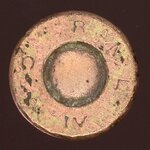Erik in NJ
Silver Member
- Oct 4, 2010
- 4,037
- 3,043
- 🥇 Banner finds
- 1
- Detector(s) used
- Minelab Explorer SE Pro & CTX-3030
- Primary Interest:
- Metal Detecting
I found this on a former British island and I believe that it's still live. It appears that it has a crimped top of some sort. Is this a blank or practice round? The length is approximately 2-3/16" and the diameter of the base is 1/2". I can see an "R", "/|\" (type design), and an "L" at 12, 1:30, and 3 o'clock. A "C" or an omega at 9 o'clock. And the Roman numerals "IV" at 6 o'clock. I'm not sure if it's WW I or WW II vintage, but just curious if anyone can tell me anything about it as well as the odd crimped top. If it is live, how careful do I need to be in handling/storing it? Thanks for any info!!
Attachments
Last edited:





![303_blank[1].jpg](/data/attachments/616/616942-411767b461d0db33f155def58b840649.jpg)
 I believe that it is a blank for launching grenades and the WW I timeframe would put it in the right timeframe of the nearby fort's date, though this area must have seen action much earlier, because I also found a dropped musket ball at the same site. I have many other similar fired crimped shells from another site on the island which I'll now have to clean up and compare. Thanks again.
I believe that it is a blank for launching grenades and the WW I timeframe would put it in the right timeframe of the nearby fort's date, though this area must have seen action much earlier, because I also found a dropped musket ball at the same site. I have many other similar fired crimped shells from another site on the island which I'll now have to clean up and compare. Thanks again.



